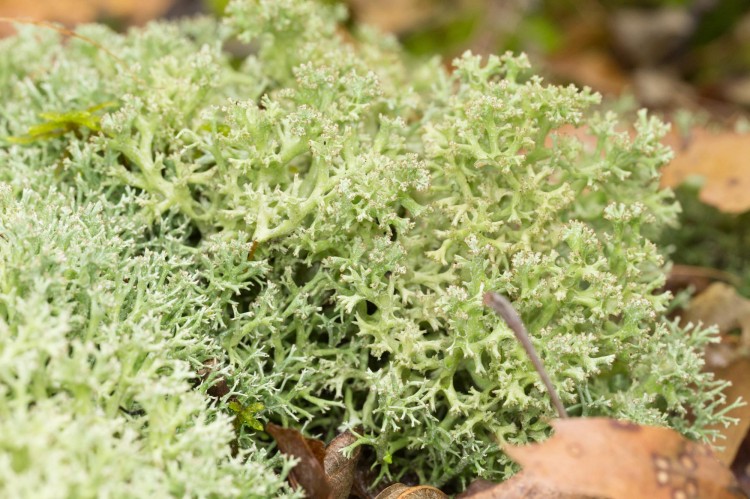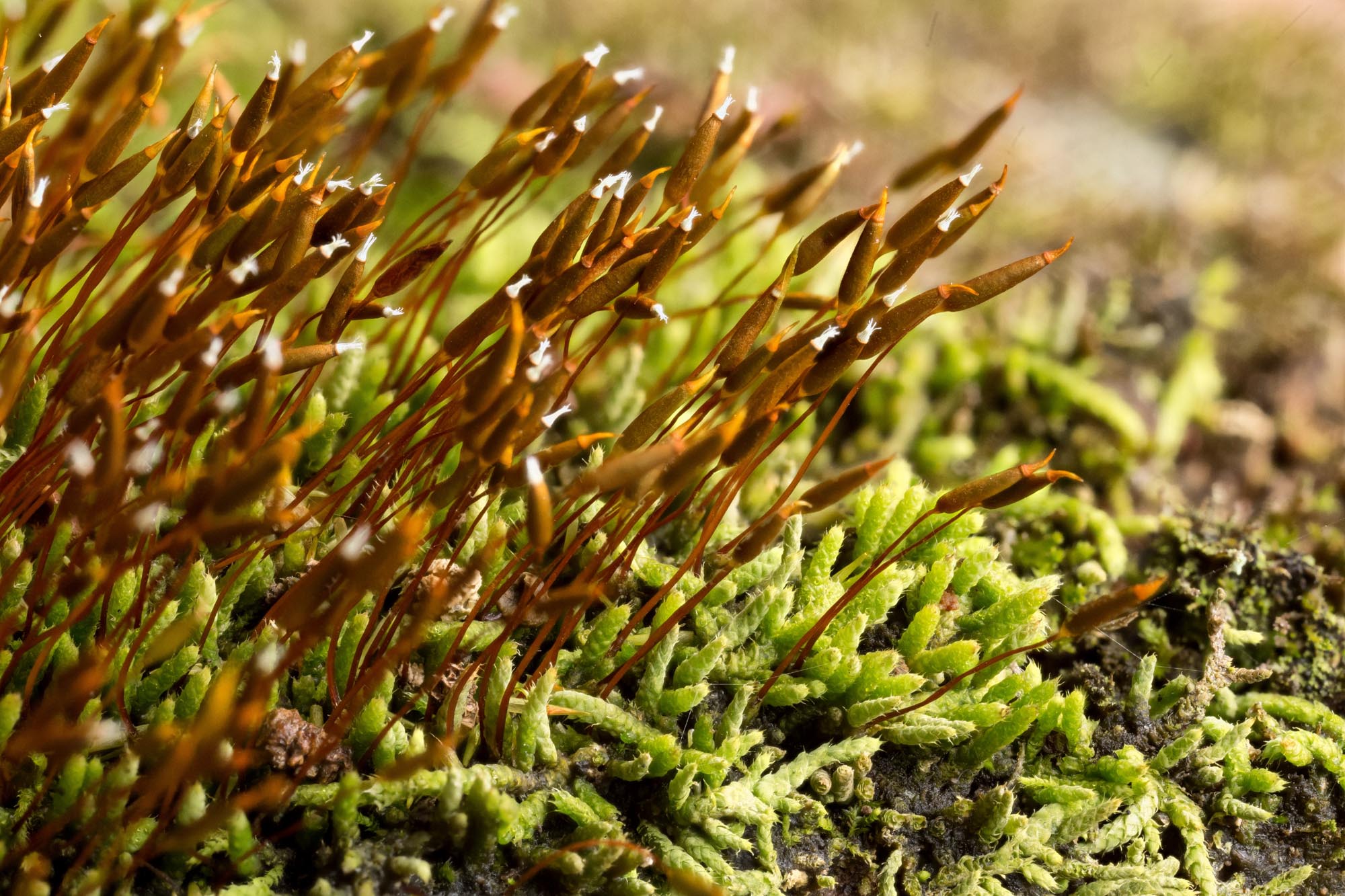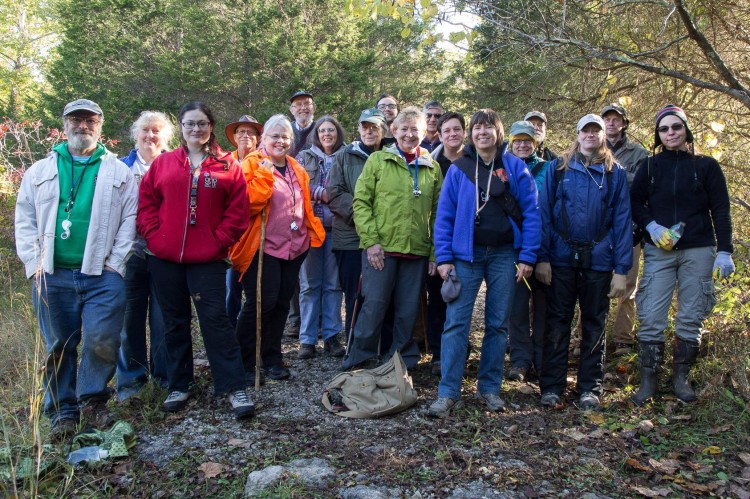Fall Foray to Edge of Appalachia (Adams County)
&
Strait Creek Preserve (Pike County)
October 3-5, 2014
To commemorate OMLA’s 10th anniversary, we returned to the scene of our first-ever foray, beautiful Adams County in southern Ohio. Exploration began on Friday afternoon, where we were privileged to explore the General Electric Engine Testing facility in northeastern Adams County. Our host was John Howard, a GE employee who is also a keen, enthusiastic, and friendly naturalist. This is a large, remote area (so that the noise doesn’t bother nearby neighbors). This largely undeveloped area contains a variety of habitats and is normally off-limits. We were fortunate to be able to visit it.
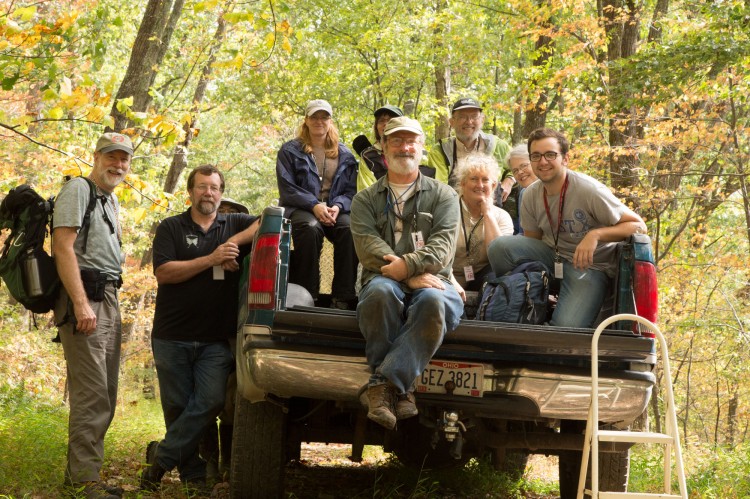
We piled in a truck. That was fun!
This area has some open wooded hillsides that were great for cryptogams. Tree bark is generally pretty good moss substrate, but (except for Orthotrichum and Ulota) most corticolous mosses occur at the base of a tree, not very high up. A delightful exception, not very often encountered, is Forsstroemia trichomitria.
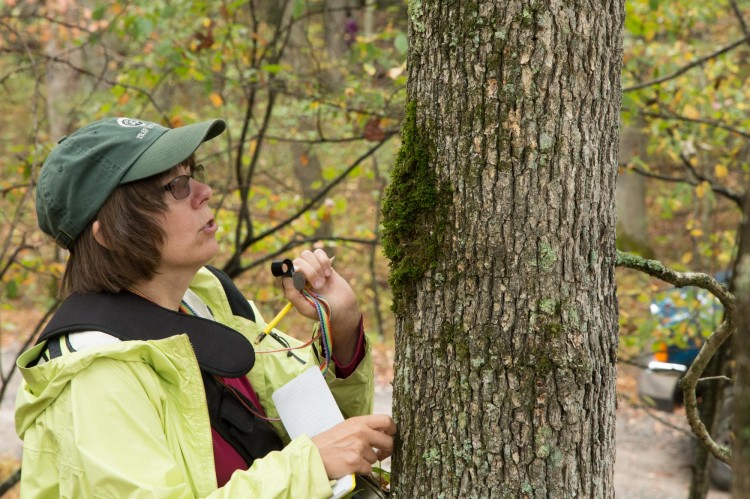
Forsstroemia trichomitria and Janet carry on a conversation.
Like the people who study them, mosses and lichens often occur together. Here along the margin of a case-hardened hunk of coarse woody debris, Leucobryum glaucum (or, perhaps more likely, L. albidum) and one of the “pixie cup” cladonias nestle together.
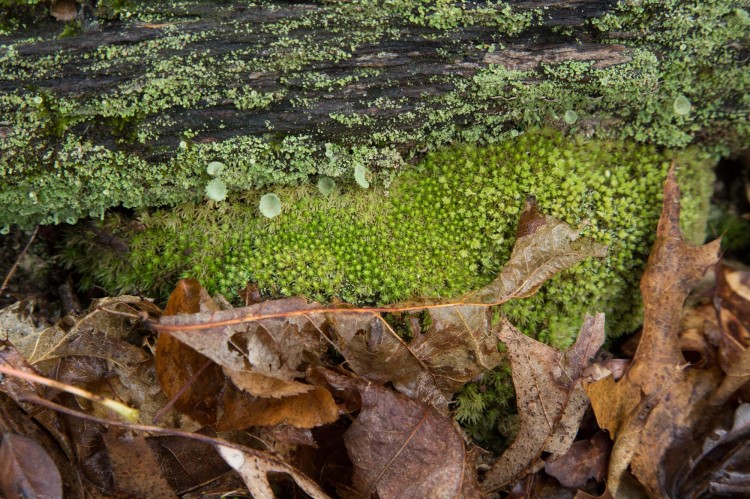
Leucobryum and Cladonia.
The lichen genus Cladonia includes several species of tangled ones informally called “reindeer lichens.” This is one of them, Cladonia uncialis.
A moss of extraordinary form is Diphyscium foliosum. The gametophyte leaves are dark, strap-shaped and easy to miss if they are by themselves on the rocks or acid organic soil, often thinly covering rocks. When sporophytes are present, the moss is unmistakable, as the capsules are sessile, and resemble (somewhat) a grain of wheat.
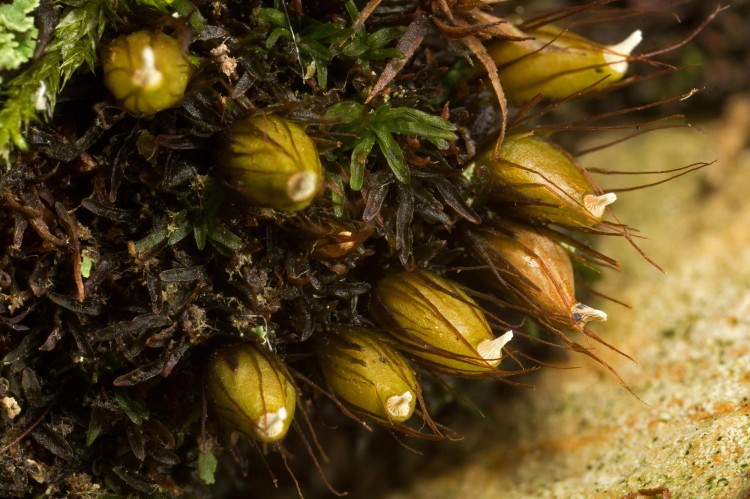
Diphyscium foliosum is “grain of wheat moss.”
Something else wonderful, but neither lichen nor moss, came to us from the animal kingdom. This is a very special “mole” (i.e., lunged, as opposed to your typical “lungless” salamander, i.e., the little ones. such as the red-backed, that you find beneath logs and rocks). It’s the marbled salamander, Ambystoma opacum. Unlike our other Ambystoma species, which breed in wet vernal vernal pools in late winter/early spring, this one breeds in such pools in autumn, when they are largely dried up. The large wet eggs that are protected by the female, and over-winter until they hatch the following year, when the pools are full.
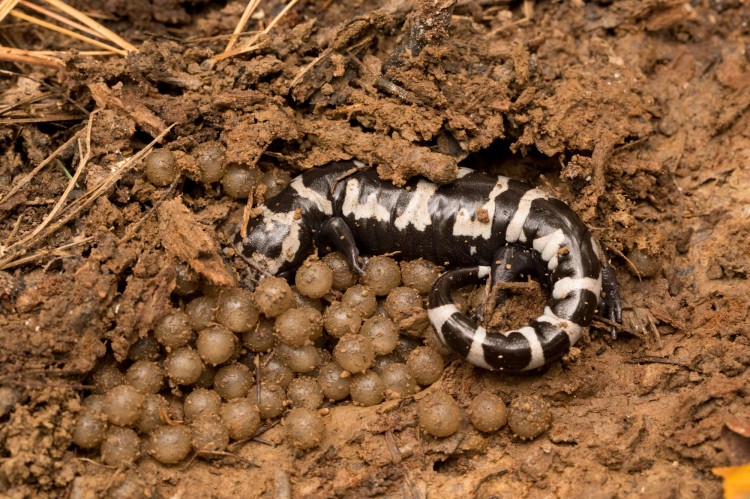
Marbled salamander protects a clutch of large water-filled eggs.
The location of Saturday’s expeditions was the Edge of Appalachia. The “Edge” is a magnificent 16,000 acre system of 11 preserves, 4 of which are National Natural Landmarks. It is administered jointly by the Cincinnati Museum Center and the Ohio Chapter of the Nature Conservancy. This video explains it well, and also mentions that there are lot of lichens in this region of the state!
OMLA member and Edge of Appalachia Ecological Manager Mark Zloba was our guide for this portion of the foray. (Mark also hosted our lodging and study at the wonderful new Eulett Center where our “scope room” identification laboratory was up and running full throttle both Friday and Saturday evenings.)
Saturday morning was spent at Charles A. Eulett Wilderness Preserve Trail. This area includes both forest and open glade with exposed dolomite. This type of rock is an excellent lichen substrate, and its prevalence here in Adams County is partly the reason why Adams, with 160 species, is Ohio’s leading county for lichen diversity. We saw this squamulose lichen, Psora pseudorussellii.
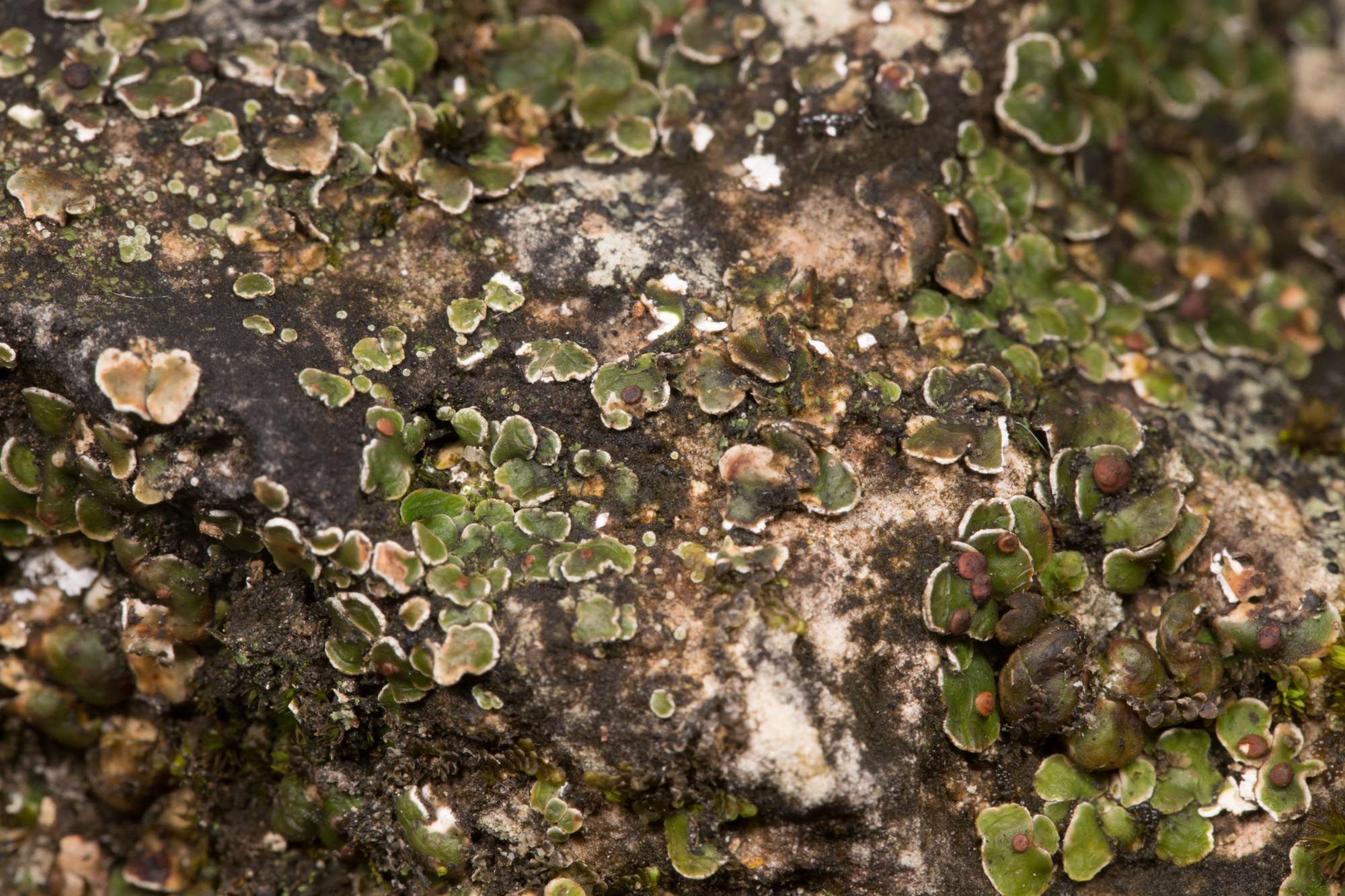
Psora pseudorussellii on the rocks.
On a sun-baked tree stump nearby, we saw a distinctive gray-green moss with worm-like stems arranged in a roughly feather-like (pinnate) arrangement. It was producing abundant sporophytes. This is Thelia asprella.
About mid-day we gathered for an “official” group picture.
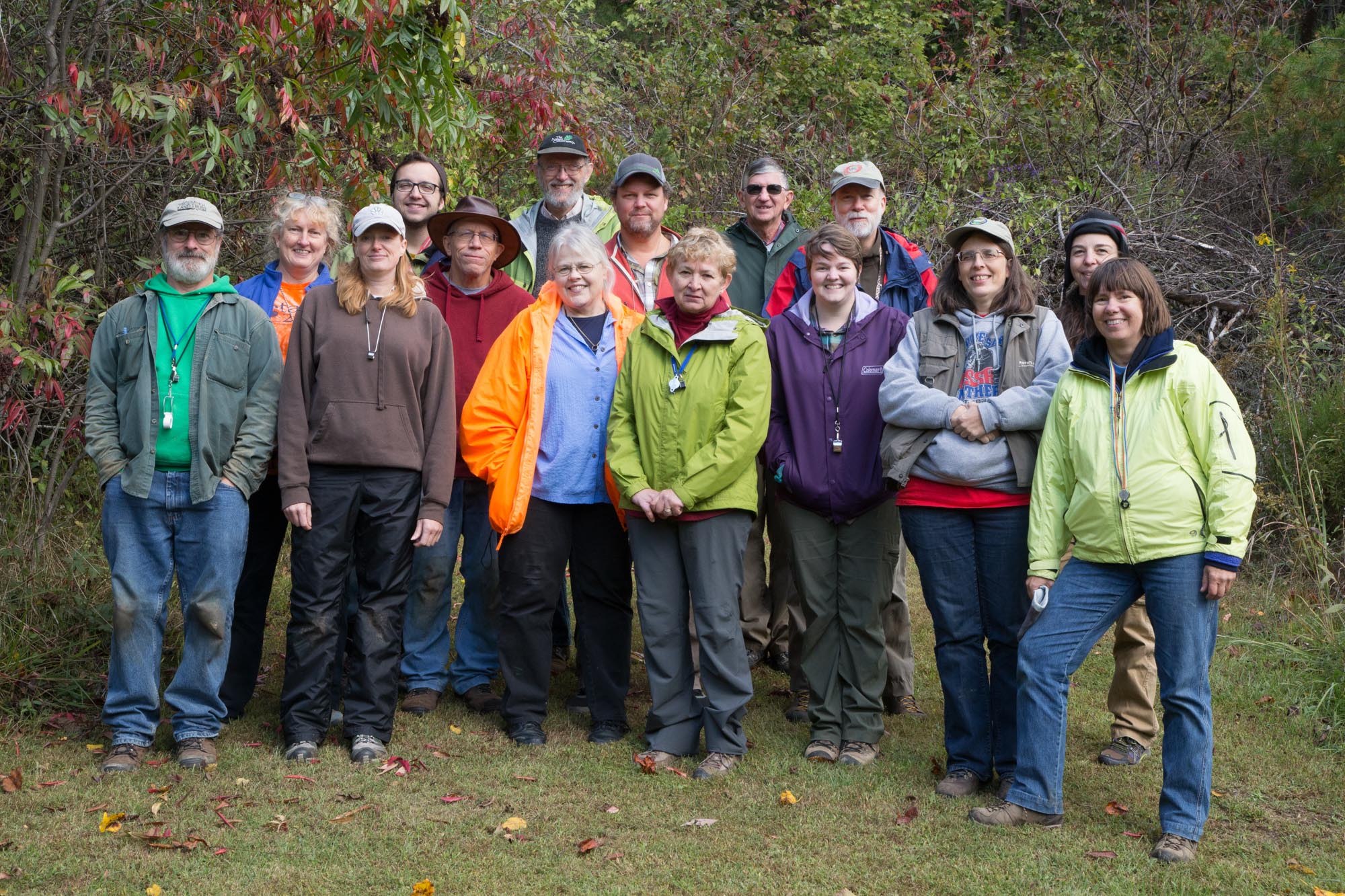
OMLA at Wilderness. October 4, 2014.
After lunch we went to the Christian and Emma Goetz Buzzardroost Rock Preserve, an older preserve (opened in 1967) but one which just this year has had an additional section of trail added, plus a new trailhead. Here we saw rather extravagant growth of a distincntive moss, Fissidens taxifolius. The genus Fissidens can be distinguished from most other mosses by it arrangement of leaves, in strict two-ranked fashion.
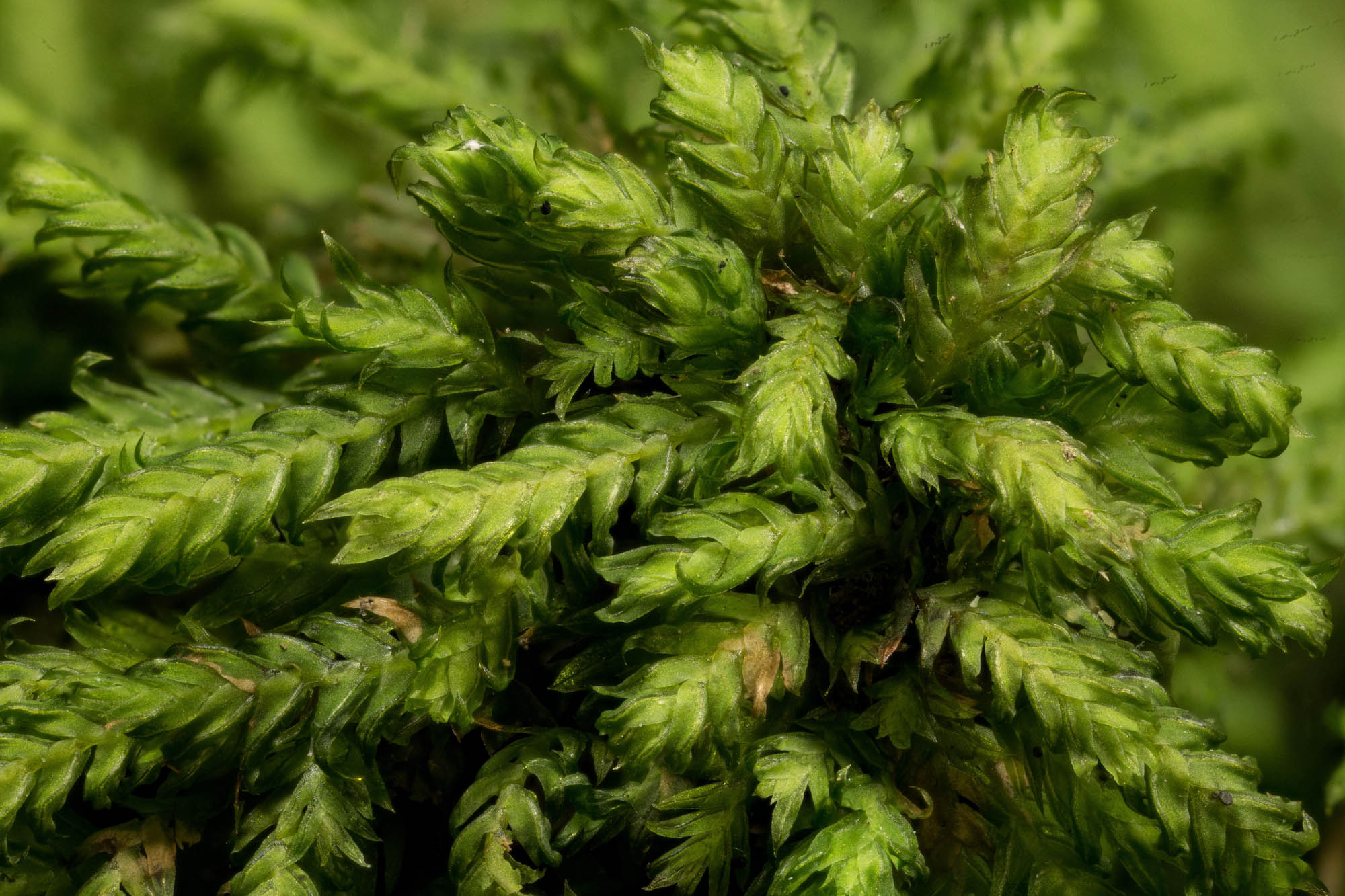
Fissidns taxifolius.
In the evening we had a wonderful dinner of pulled pork and other goodies in the Eulett Center dining room. It was also the occasion of the OMLA birthday celebration. Hooray!
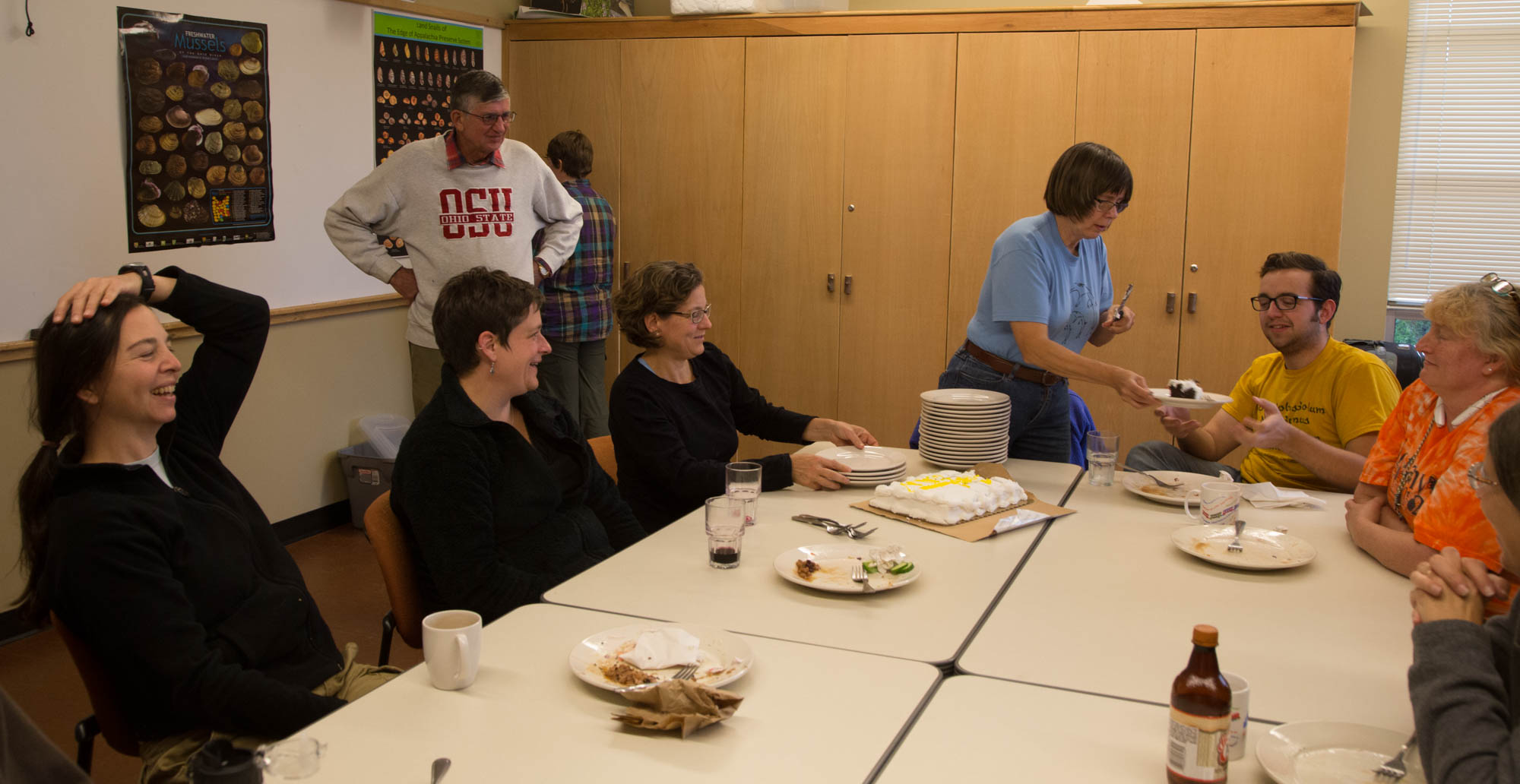
Happy Birthday to us…!!!
Sunday morning was spent at at Nature Conservancy property in Pike County, Strait Creek Prairie Bluff Preserve, where we were met by former TNC Land Manager Dave Minney. Davegraciously showed us around, and explained the unique botany and geology of the area –a forested creek valley, prairie glades and a dolomite cliffs ridge system.We also posed for yet another group photo.
Several plants with “moss” in their common name are decidedly not mosses, although one could be forgiven for thinking so. Here’s meadow spikemoss, Selaginella apoda. This is a primitive (seedless) vascular plant, similar in some ways to the also-misnamed clubmosses, and like them, are classified as “lycopods” (phylum Lycopodophyta).
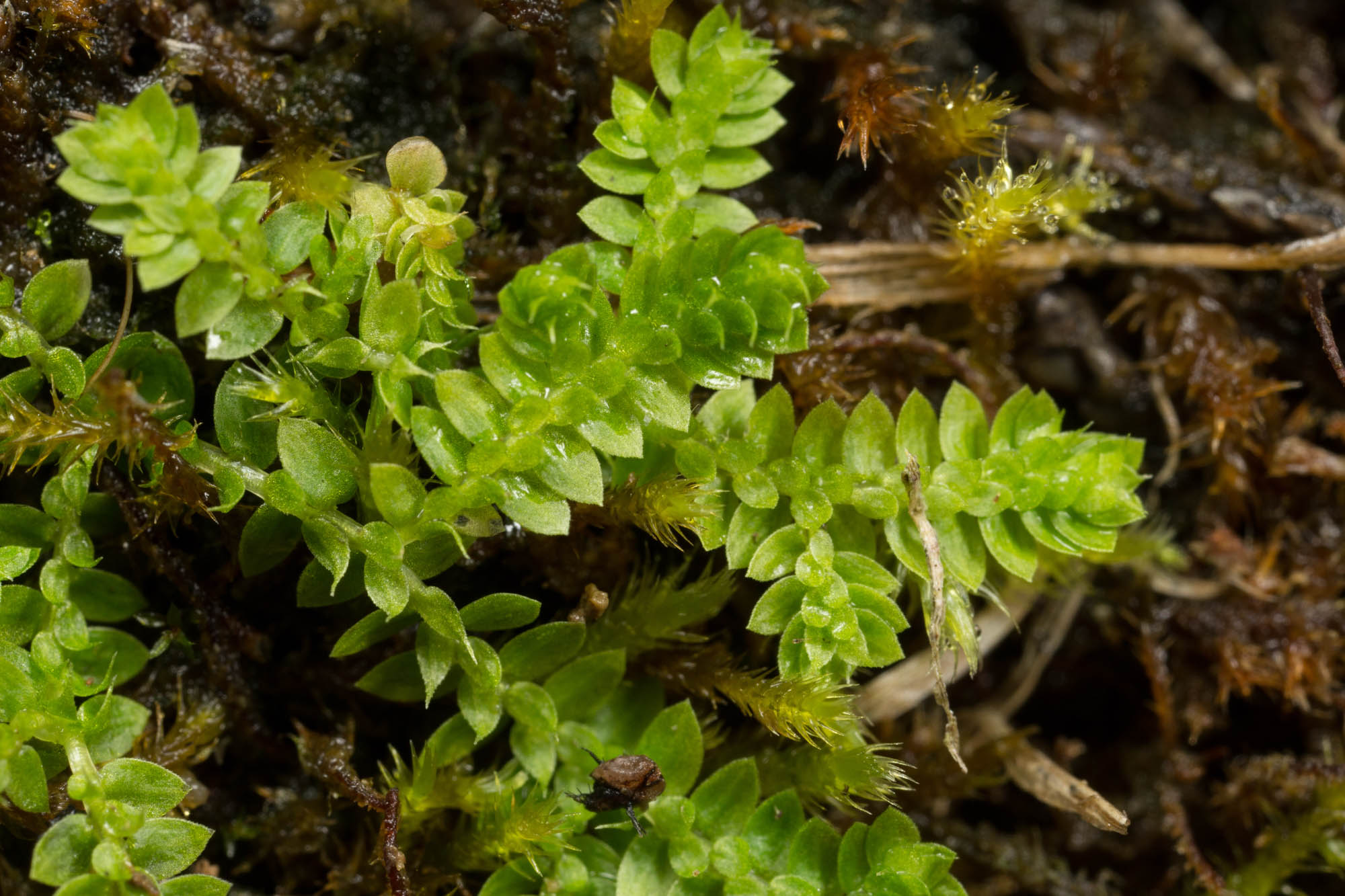
Meadow spikemoss is a vascular plant in the phylum Lycopodophyta.
An early study of the bryophytes of the edge of Appalachia (Osterbrock, A.J. and J.A. Snider. 1985. A checklist of the bryophytes of the Edge of Appalachia preserve system, Adams County, Ohio. Ohio J. Sci. 85(3): 138–143) can be seen HERE
For further information about this most excellent foray, look in Vol. 11 (2014) of the Association’s newsletter, OBELISK.
Lichens of the 2014 Fall Foray in Adams and Pike Counties
* = new county record
G = GE Testing Facility (Adams County)
W = Wilderness (Adams County)
S =Strait Creek (Pike County)
Anaptychia palmulata G W
Candelaria concolor G S
Canoparmelia crozalsiana G S
Cladonia apodocarpa G
C. caroliniana G
C. coniocraea G W S
C. cristatella G W
C. furcata G W S
C. macilenta G W S
C. peziziformis G W
C. piedmontensis G
C. subtenuis G W S
C. uncialis G
Collema conglomeratum W
C. subflaccidum W
Dermatocarpon luridum W
D. muhlenbergii W S
Evernia mesomorpha W
Flavoparmelia baltimorensis G
F. caperata G W S
Flavopunctelia soredica G
Heterodermia granulifera S*
H. obscurata G W S
H. speciosa G W
Hypotrachyna livida G W
H. showmanii G
Imshaugia aleurites W
Leptogium cyanescens G W
Melanelixia subaurifera S
Myelochroa aurulenta G W S
M. galbina G W S
Parmelia squarrosa W
P. sulcata G W S
Parmelinopsis minarum G
Parmotrema chinense W
P. crinitum W S*
P. hypotropum G W S
P. reticulatum G W
P. stuppeum G W
Peltigera canina G S*
P. elisabethae W
Phaeophyscia adiastola G W S
P. hirsuta W
P. pusilloides W
P. rubropulchra G W S
P. squarrosa W S
Physcia americana G W S
P. millegrana G W S
P. pumilior W
P. stellaris W S
Physconia detersa S
Punctelia caseana G W S
P. missouriensis G W S
P. rudecta G W S
Pyxine sorediata G W S
P. subcinerea G W S
Ramalina americana W
Usnea strigosa W S
Xanthoparmelia plittii G
Total species 59 (GE 39, Wilderness 44, Strait Creek 30)
Bryophytes of the 2014 Fall Foray in Adams and Pike Counties
* = new county record
G = GE Testing Facility (Adams County)
W = Wilderness (Adams County)
E = Easter Run (Adams County)
S =Strait Creek (Pike County)
Mosses
Anomodon attenuatus G S
A. minor G
A. rostratus S
A. viticulosus E
Atrichum altecristatum S*
A. angustatum G
Aulacomnium heterostichum S
Barbula unguiculata G S*
Brachythecium laetum S
B. falcatum G* W* S*
B. plumosum G S*
Bryoandersonia illecebra G S
Callicladium haldanianum W
Calliergonella lindbergii S
Campylium chrysophyllum W E S
C. stellatum S*
Clasmatodon parvulus G
Ctenidium malacodes S
Cyrto-hypnum minutulum E
Dicranum fuscescens G*
D. montanum G W S
D. scoparium G
D. viride S
Didymodon tophaceus E
Diphyscium foliosum G
Encalypta procera S
Entodon seductrix G W
Eucladium verticillatum E*
Fissidens dubius W S
F. subbasilaris G S
F. taxifolius S*
Forrstroemia trichomitria G
Gymnostomum aeruginosum E S
Haplohymenium triste G W S
Hedwigia ciliata G
Hyophila involuta E
Hypnum curvifolium S
H. imponens G
Leskea gracilescens G
Leucobryum albidum G
Leucodon julaceus G W S
Mnium marginatum S
Myurella sibirica S
Orthotrichum ohioense G
Plagiomnium ciliare G S
P. cuspidatum S
Platygyrium repens G E S
Pleurozium schreberi G
Pogonatum pensilvanicum G
Pohlia wahlenbergii S*
Polytrichastrum ohioense G S
Pylaisiadelpha tenuirostris G
Rhynchostegium serrulatum G
Schistidium apocarpum W S
Schwetschkeopsis fabronia E
Sematophyllum demissum G
Taxiphyllum deplanatum E
T. taxirameum S*
Thelia asprella G
T. hirtella G
Tortella humilis W S
Thuidium delicatulum G
Total Mosses 62 (GE 33, Wilderness 10, Easter Run 10, Strait Creek 33)
Hornworts
Anthoceros laevis G S
Liverworts
Cololejeunea biddlecomiae E
Conocephalum salebrosum G
Fossombronia foveolata G
Frullania eboracensis G W S
F. inflata W
Leucolejeunea clypeata G*

